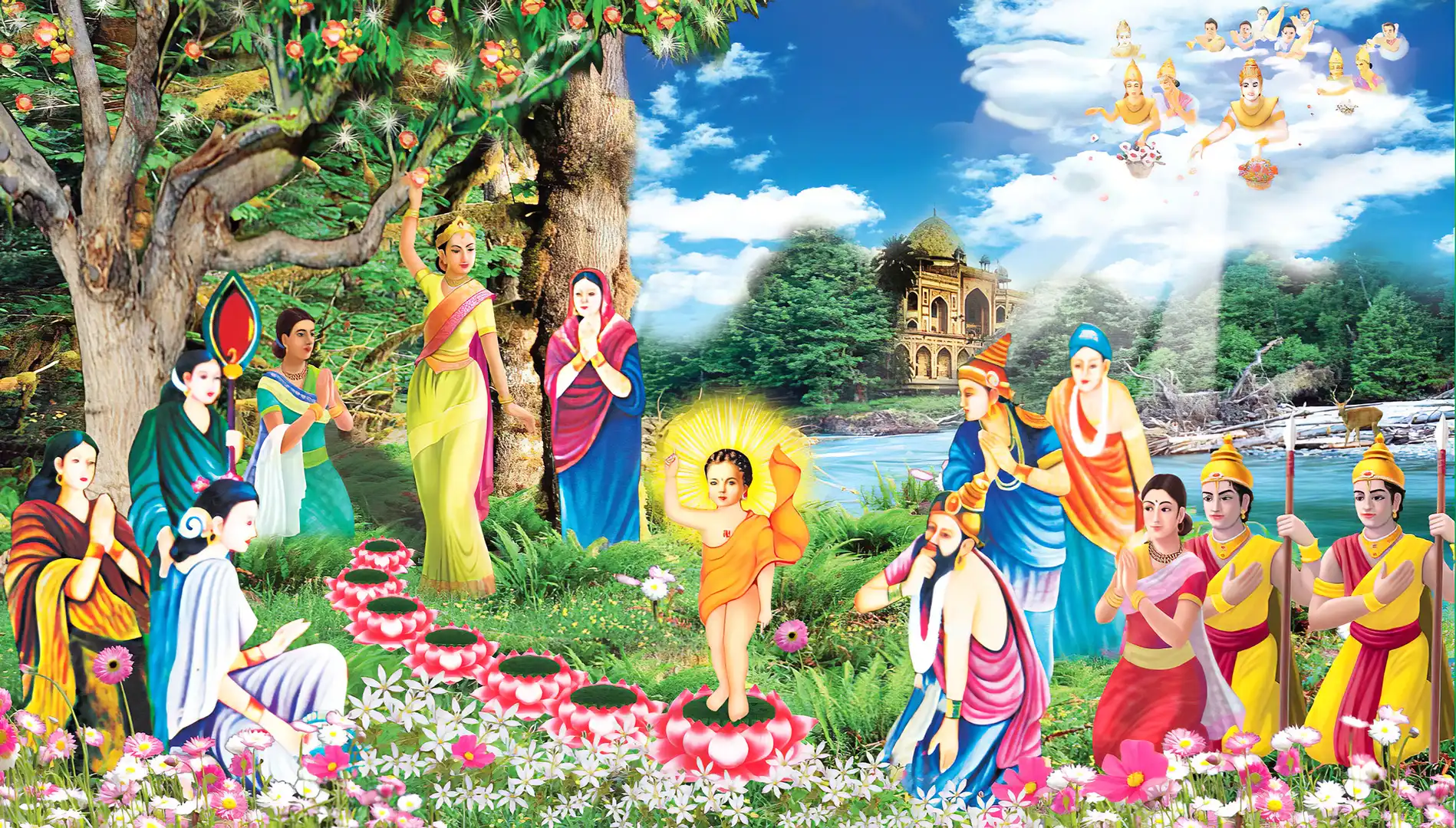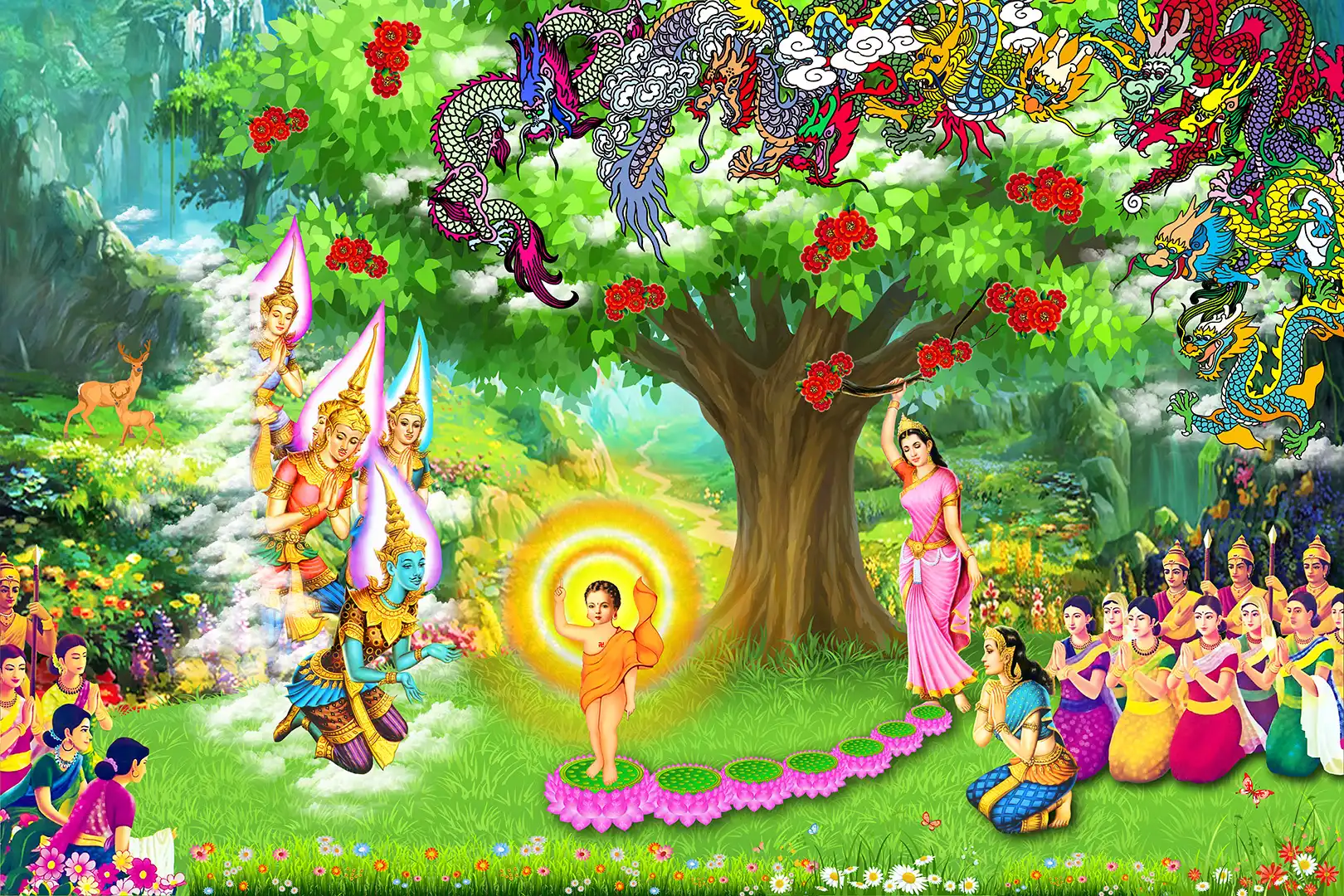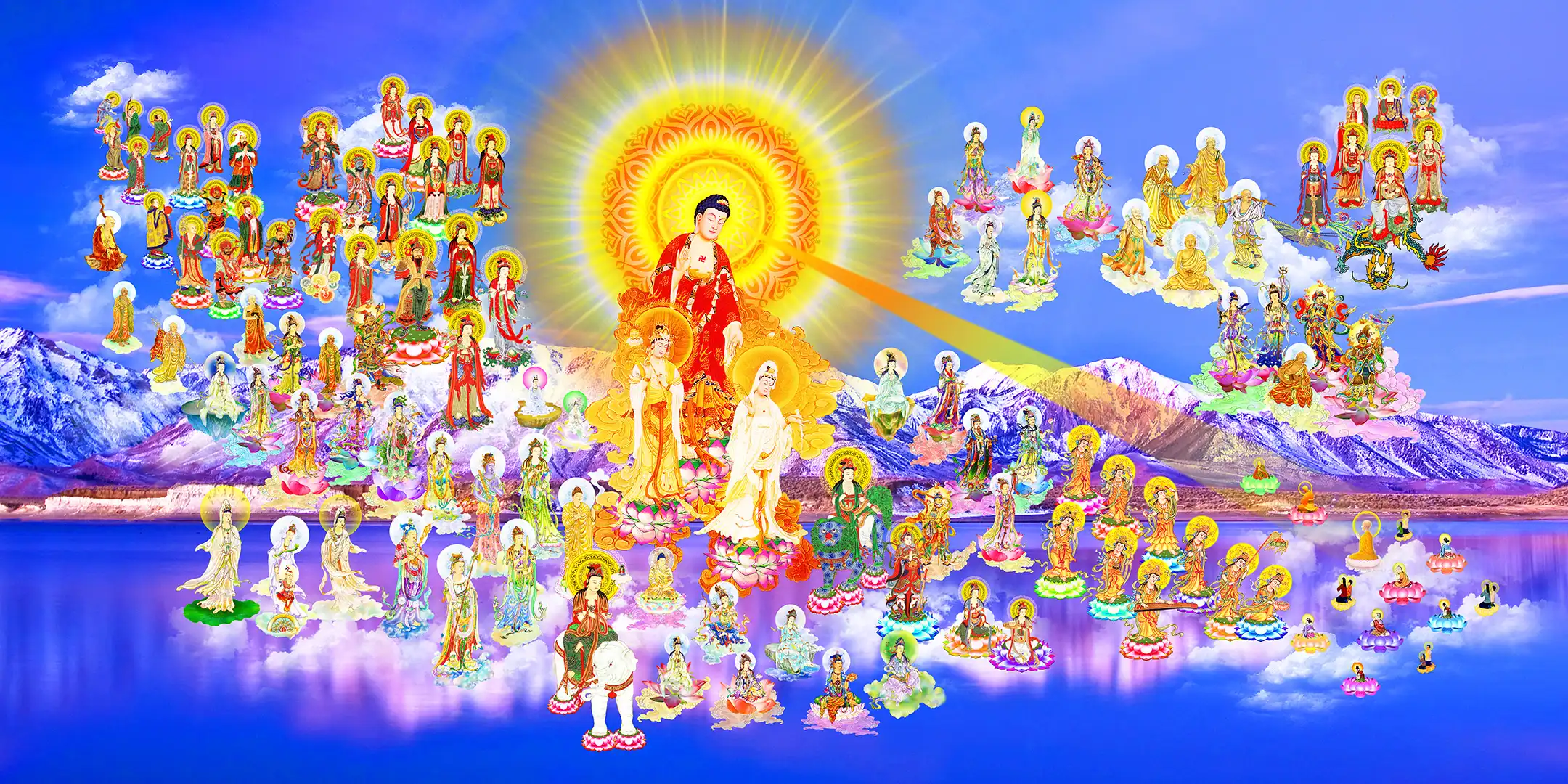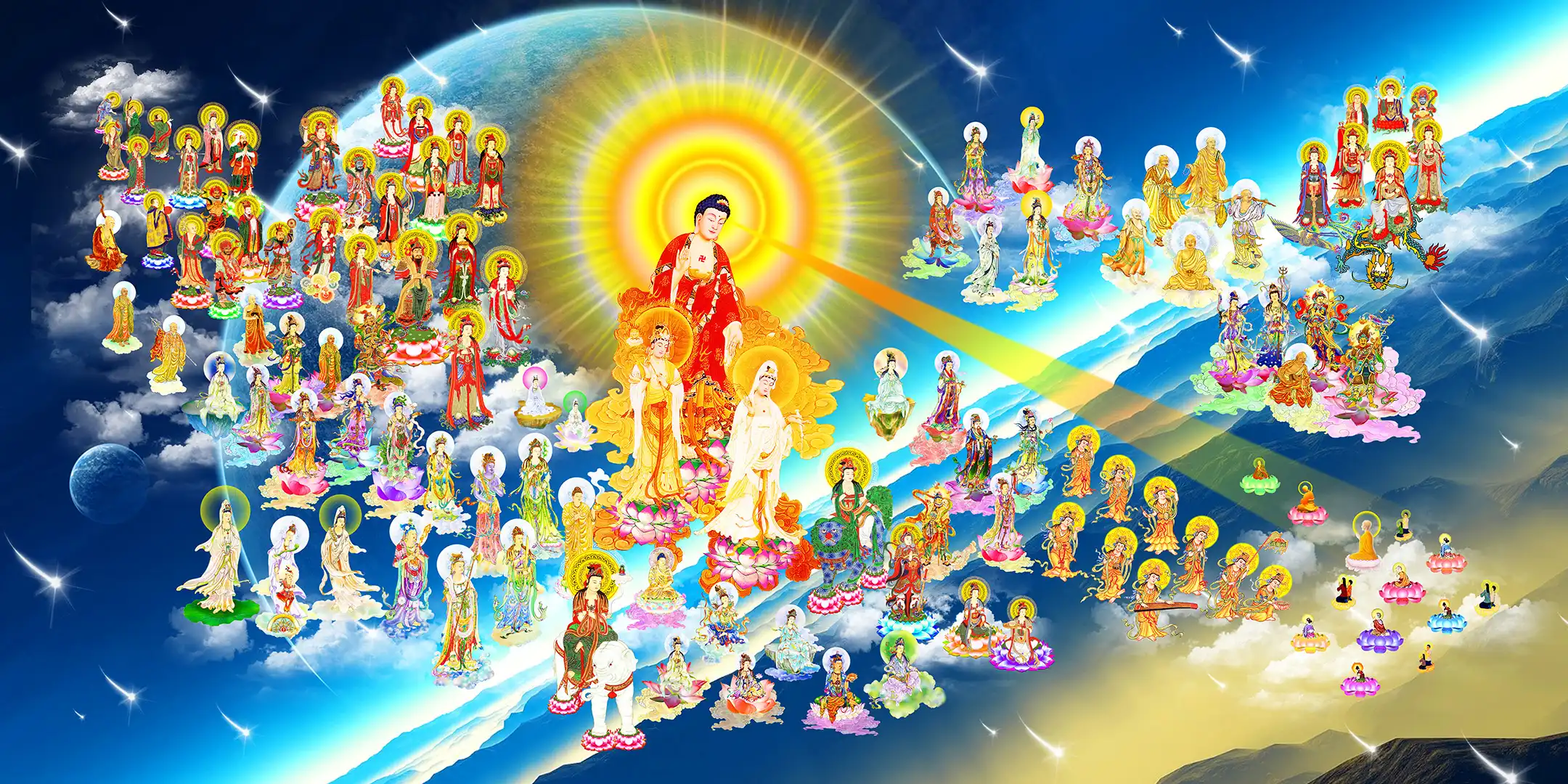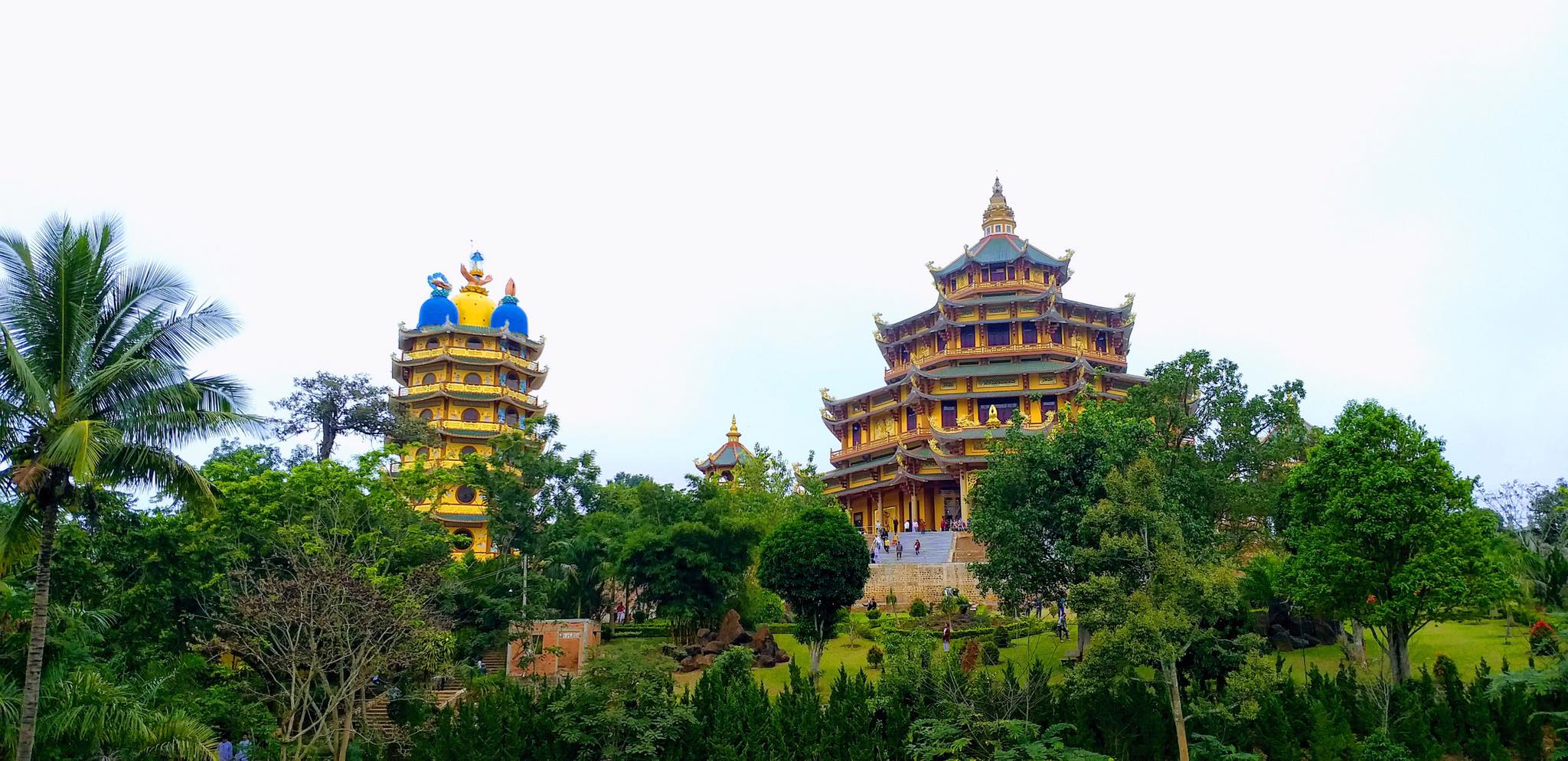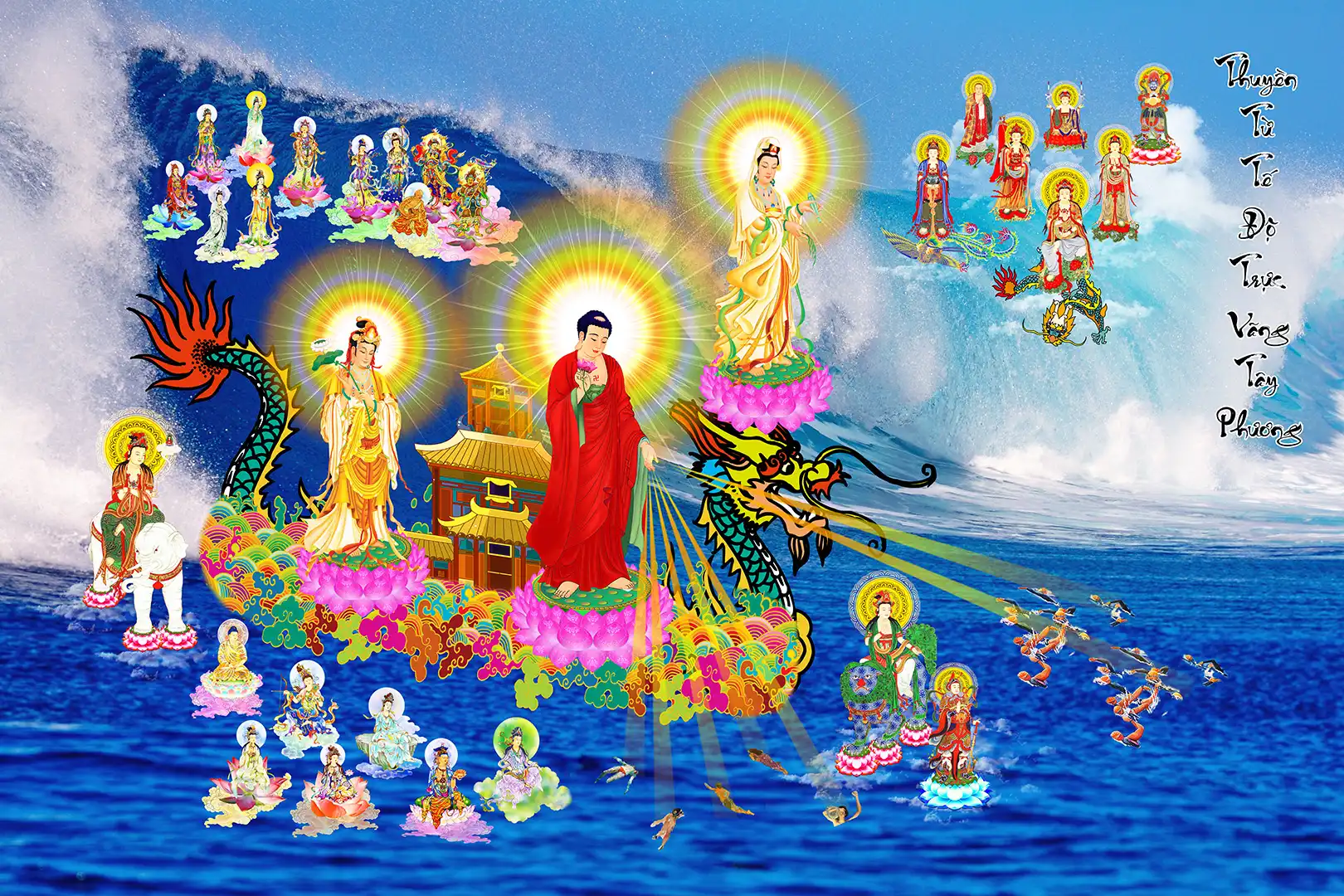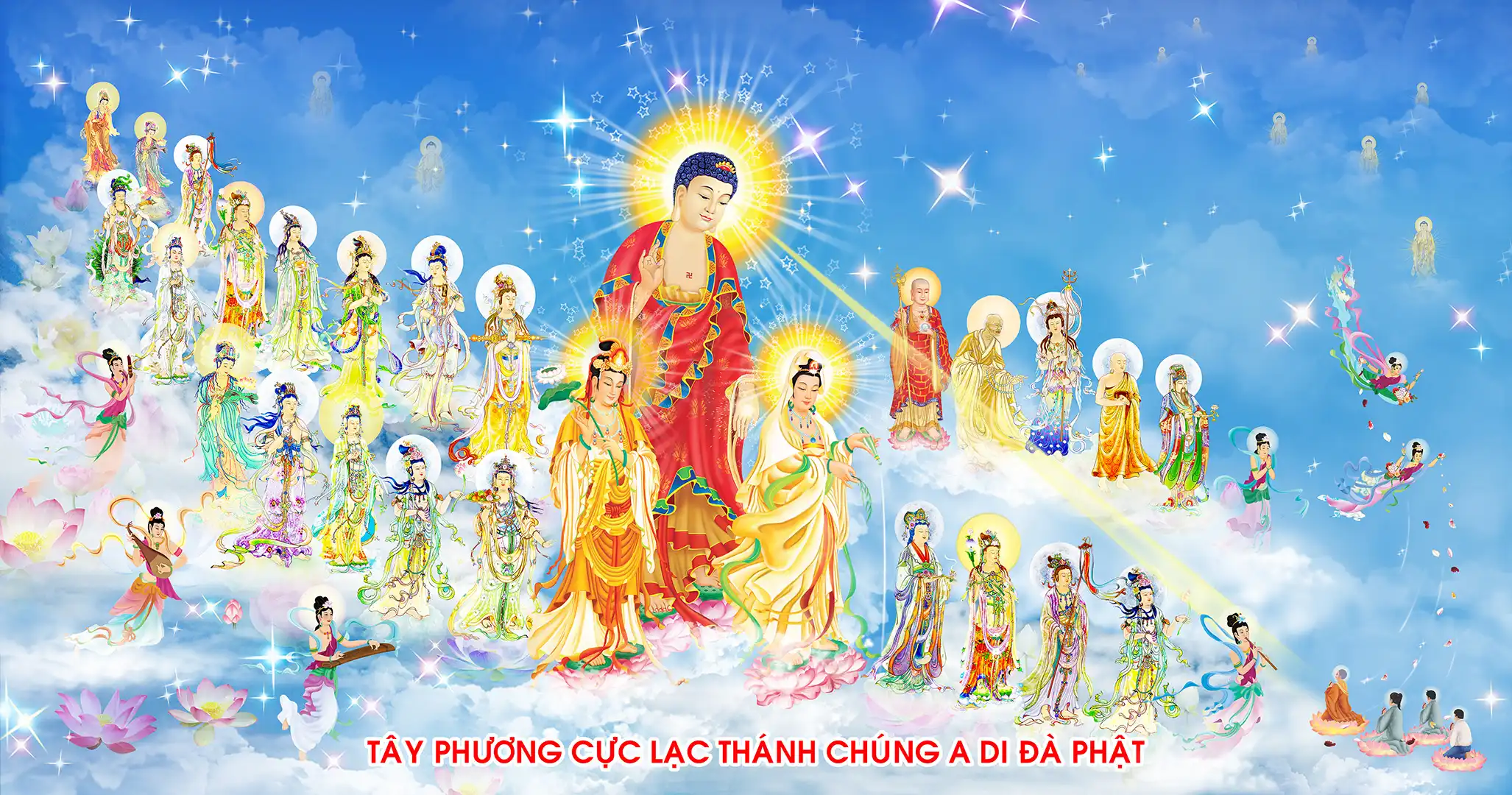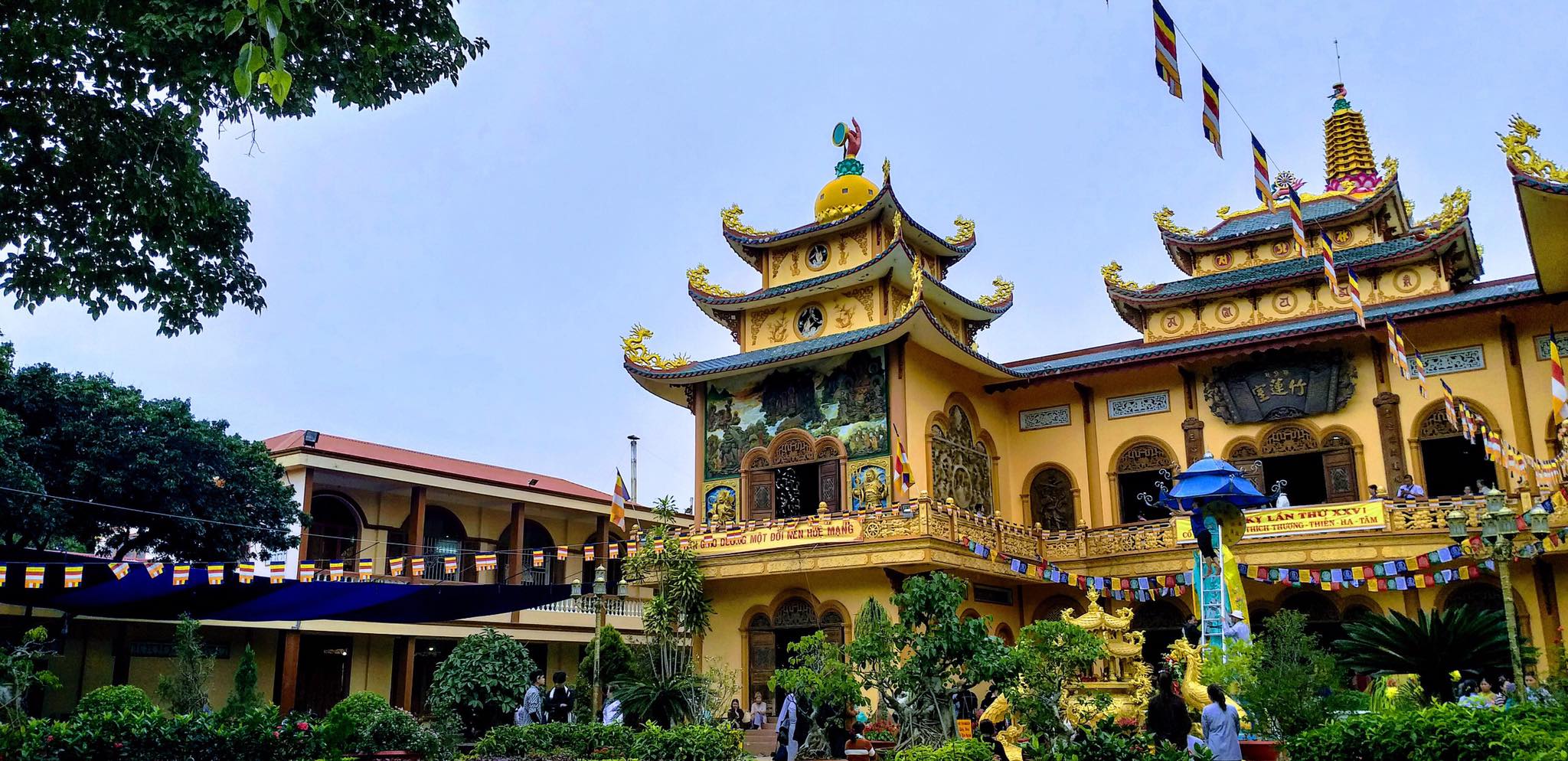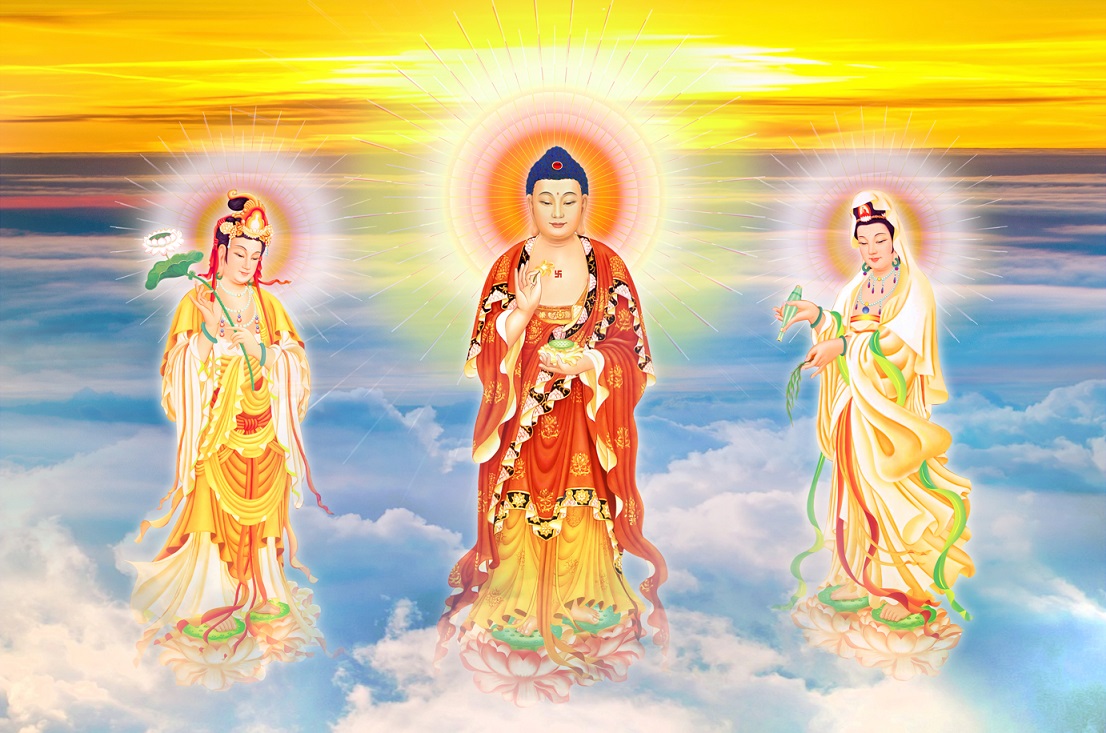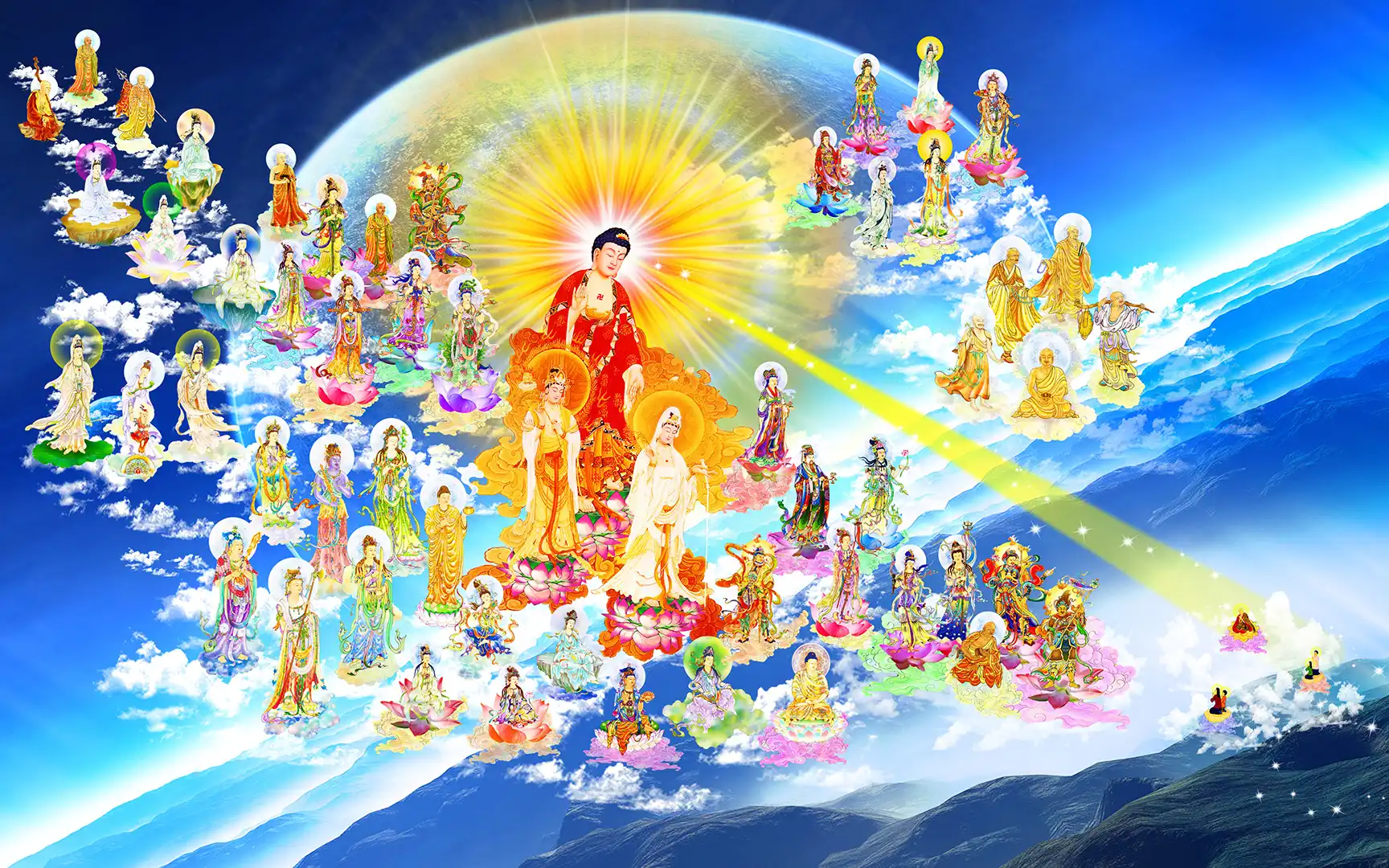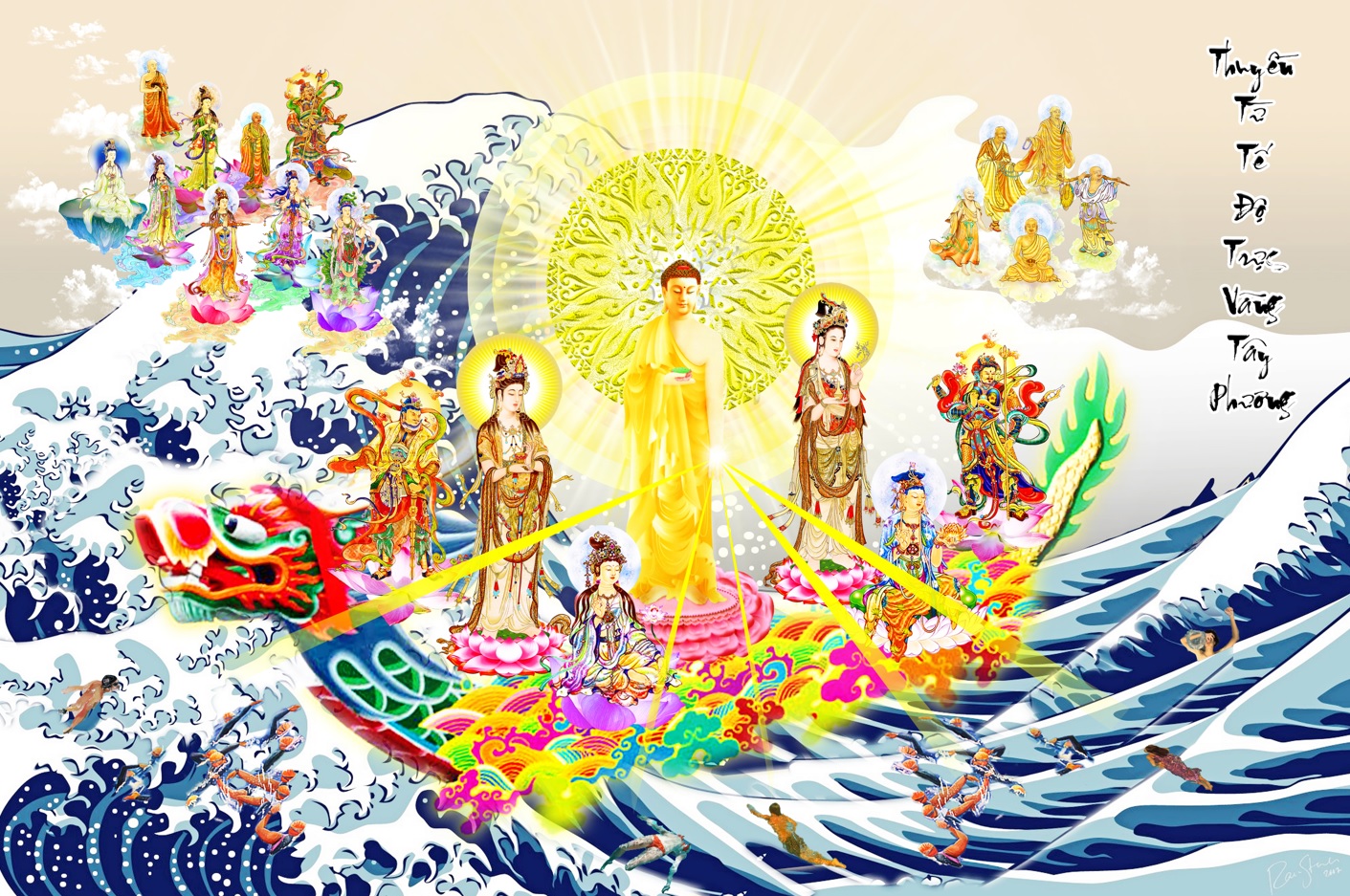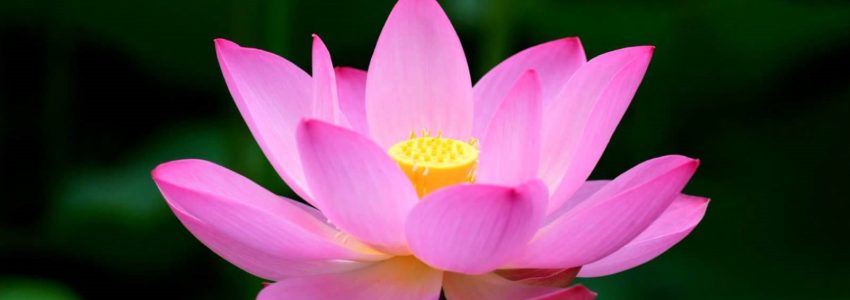REBIRTH VIEWS
IN THE SURANGAMA SUTRA
(Fifth Edition)
Dr. Bhikkhunī Giới Hương

CHAPTER XIV
IMMORTALS, HEAVENS, AND ASURAS
Immortals
Theravāda Sūtras in the beginning period often teach that there are six realms in the universe, but later in the Mahāyāna Sūtras, they add one more realm of immortal. Therefore, we have seven realms, such as heaven (deva), immortal (half devahuman), asura (asurakāya), human (manussa), hell (niraya), hungry ghosts (pittivisaya), and animal (tiracchānayoni) realms.
In the previous chapter, we mentioned the hell, hungry ghosts, and animal worlds. In this chapter, we talk about three worlds of immortals, heavens, and asura.
Immortals are higher than human beings or the half devahuman beings. They do not keep the Buddhist preceptconcentration-wisdom to attain samādhi, but they follow false thought to maintain the body for a long time in the mountains and forests where people fail to reach. They become ten kinds of immortals as follows:
1. Ānanda, there are living beings who determinedly take the nutritious medicine without stopping until their method of ingestion succeeds. They become the earth-acting immortals.
2. There are living beings who determinedly use the whole grasses and herbs without stopping until their method of medicine succeeds. They become the fly-acting immortals.
3. There are living beings who determinedly train the metal and stone without stopping until their method of transformation succeeds. They become the roam-traveling immortals.
4. There are living beings who determinedly use the activity without stopping until their method of atmosphere core is succeeded. They become the space-acting immortals.
5. There are living beings who determinedly train the saliva without stop until their method of penetration succeeds. They become the heaven-acting immortals.
6. There are living beings who determinedly train the whole essence of sun and moon without stopping until their method of consummation succeeds. They become the penetrate-acting immortals.
7. There are living beings who determinedly chant the whole mantras and spells without stop until their method of mystery succeeds. They become the way-acting immortals.
8. There are living beings who determinedly train their thought without stopping until their method of focusing succeeds. They become the illuminate-acting immortals.
9. There are living beings who determinedly train the whole intercourse of water and fire without stopping until their response method succeeds. They become the essentialacting immortals.
10. There are living beings who determinedly train the whole transformation and change without stopping until their method of enlightenment succeeds. They become the absolute-acting immortals.
Ānanda, these immortals who are in human realms who train their minds in the wrong way of enlightenment, aim to obtain some special way to live long for tens thousands of years, and favor to stay in the deep mountains or on the islands in the oceans far away the human world. However, they are still the false thought of the saṃsāric wheel. If they do not cultivate samādhi, once their retributions are ended, they must return the six realms.”1
The immortals leave the noisy luxury world behind to dwell in the deep caves, mountains, islands, and remote areas where human beings fail to come. Their aims are to maintain the long life as angels without death, and they do not feel interested in practicing the āsrava triple of precept-meditationwisdom.
Because they cultivate their own way for maintaining life, they must attain the false fruits. They also obtain the superpower, joyfulness, and long span. However, no matter how long life they have, they cannot be out of the cycle of rebirth and death (saṃsāra). After ending their lives and merits, they are still subject to fall into the low realms.
1. The earth-acting immortals: The immortals know well what kinds of nutritious herbs or foods are useful for maintaining their body. Honestly, we do not really know about it, so we take many doses of delicious food to feed the body, but it turns out to poison us. The immortals experience how to take wholly the nutritious food day after day. As a result, they become the beautiful immortals who walk gentlly on the earth.
2. The fly-acting immortals: the immortals taste each flavor of grasses and herbs to recognize well which kind of herbs can cure the sickness. As the physician, he cuts, dries, or fires herbs or trees, then he crushes it into powder which is used as medicine. Likewise, because the immortals take this whole medicine herbs every single day without fail so that their bodies respond and become the fine divinity. Due to their determining this method without stopping, and as their methods eventually start to work, their bodies are light as flying.
3. The roam-acting immortals: The immortals have mixed gold, silver, mercury, and lead together, and then they crush, penetrate in water, heat and make these ingredients to be the nutritious medicine of immortality. Due to their determining this method without stopping, and as their response methods succeed, they can walk fast as running. It proves the positive health, quick, and solid of the roaming immortals’ bodies.
In Vũng-tàu Beach, Thị-vải Mount, Bà-rịa Province, there is a man who lives in a tent, sleeps on the hammock, and eats vegetables which he planted. His job is to carry things for villagers at the mountain foot. Every morning, he goes to the bottom of the mountain to earn money and in the evening, he comes back his tent. From the bottom to the top of the mount, he goes as fast as a running rabbit while normal people feel tired to climb up. Maybe he cultivated the roaming immortal in his past lives, so this life he is quick and can live on the peak alone.
4. The space-acting immortals: The immortals determinedly train in the standard method of body exercise. They practice hard the whole movements without stopping until succeeding, then their bodies become strong and light. At the time, they can walk in space and fly delicately as the passing wind, which we fail to recognize.
5. The heaven-acting immortals: The immortals determinedly make themselves strong by using the whole saliva in a regularly scheduled practice. The saliva is nutritious and good medicine for body. When they have perfected the response method of this liquid, they are known as the heaventraveling immortals.
6. The penetrate-acting immortals: The immortals determinedly make themselves strong with the essence of the sun without stopping. In the morning, noon, and afternoon, they look at the sun without blinking to collect the essence of the sun until it penetrates into their body. Once they have perfected the inhalation of this sun energy, these immortals are called the penetrate-traveling immortals.
7. The way-acting immortals: The immortals determinedly train themselves with reciting wholy mantras and spells. As this mantra method succeeds, they have some magic powers on movement, known as the way-acting immortals.
8. The illuminate-acting immortals: The immortals determinedly train their whole mind without stopping. When they succeed in this practice, they are transformed into luminous light and is known as the illuminate-acting immortals.
9. The essential-acting immortals: The immortals determinedly train the whole intercourse of water and fire without stopping until their response method succeeds, they become the essential-acting immortals.
10. The absolute-action immortals: The immortals determinedly train the wholly transformations of Dharma tricks without stopping. When they succeed in developing transformations, they become acquainted with the doctrine of creation. Since then, they are called the absolute-action immortals.
In brief, there are many names of the immortals (half deva-human) and many methods of cultivation to be the immortals. Thanks to the Buddha in this sūtra we learn that there are ten kinds of immortals in the world.
At each kind of immortal, the Buddha mentioned that the resolution or determination without stopping is very necessary for cultivation. They cannot gain their purposes as immortals if they are not devoted with hard training. They must possess the strong spirit, health and long lifespan to maintain their divinity methods. Although they can be everlasting, they must die at the end. Once their merits and virtues are ended, they will fall into the hells (niraya) or low worlds. Thus, the Buddha advises us that we should not follow their cultivation because they still wander round the cycle of three low realms.
THE DESIRE HEAVENLY REALMS (kāmasugati-bhūmi)
– Ānanda, some mundane people do not search for the permanent enlightenment and have not given up the craving for their wives (partners), but they really do not feel interested in sexual intercourse. Due to developing this manner, their mind generates the brightness. At the time of death, they reborn in the place near the sun and moon. Such inhabitants are known as four heavenly kings (catummahārājika).
– Some mundane people reduce the sexual intercourse with their wives (partners) and do not feel the whole taste of sexuality. At the time of death, they reborn at the top of human (manussa) world and over the sun and moon. Such inhabitants are known as the trayastrimsha heavenly beings (tāvatiṃsa, tettiṃsā).
– Some mundane people temporarily relate to sexual intercourse with their wives (partners) but they do not think on it after ending. In the human world, they are calm and untroubled. So, at the time of death, they become bright and live serenely in the space where the sun and moonlight fail to reach. Such inhabitants have their own light, known as the suyama heavenly beings (yāmā).
– Some mundane people are calm all the time, but they do not resist touching the flesh intercourse with their wives (partners). At the time of death, they are reborn in the subtle wonderful places where the human and heaven worlds, the destruction kalpa, and three disasters cannot reach. Such inhabitants are known as the tushita heavenly beings.
– Some mundane people do not have sexual lust, but they only respond as the duty with their wives (partners). So, they feel bothered as the flavor of chewing wax. At the time of death, they are reborn in a place of transformations. Such inhabitants are known as the blissful transformation heavenly beings (nimmānaratī).
– Some mundane people are not of the mundane mind, they only do the same as worldly people engaging in five desires. While they get involved, they feel they are transcending it. At the time of death, they are reborn in a place beyond the transformations and without transformations. Such inhabitants are known as the transforming heavenly beings of the comfort from others (paranimmitavasavattī).
Ānanda, in such six heavenly realms, their forms are transcended, but the traces of their minds still have attachment. Counting from these worlds downward, which are called the six desire heavenly realms (kāmasugatibhūmi).2
Living beings in the desire realms (kāmasugati-bhūmi) have not left the craving (trishna) and lust (sarāgaṃ). They cultivate ten precepts, practice concentration, and give things to others but they still like the sexual activity. According to the level of sexual desire, living beings will stay in the appropriate realm. The more sexual desire they like, the lower realm they will live in.
From the transformation heavenly beings of the comfort from others (paranimmitavasavattī) in the sixth realm to the other beings in low realms—all are still affected three calamities. Three calamities are fire (due to lust, there is a fire), the wind (strongly blows the bodies away), and the storm (causes everything to sink).
The transforming heavenly inhabitants of the comfort from others (paranimmitavasavattī) in the sixth realm have no kind of worldly thoughts while having five desires. For example, they dislike eating but they have to eat with other people and feel without interest. Althought they have to fulfill thei sexual duty with their wives (partners), they just don’t have any thoughts on it, like chewing wax without taste. It means their minds are not devoted to the human (manussa) and heavenly lust (sarāgaṃ). From this pure state, they can step up to the high level of the form heavenly realms without lust.
The Buddha in the form of a white elephant with six beautiful ivories from the Tushita Heaven descended to Kapilvastu Kingdom in the saha world. This is the fourth realm among six desire realms. It was the vow of Hộ Minh Bodhisattva (the previous life of Śākyamuni Buddha) to live in Tushita, except his kammic powers. In the future, Maitreya Bodhisattva also manifests in this saha world from the Tushita heaven.
Due to the great vows, the Buddhas often manifest in the world under the forms of the noble warrior clans and high positions in society. For example, the (Kshastriya) royal clan, the Sakya lineage is in the upper class, while poor people are the lower class in society.
Which cause do we cultivate to be born in the Tushita heaven? We have to keep ten precepts, practice concentration, and have less desire.
What is the difference between inner court of the Tusita Heaven and outer court of the Tusita Heaven?
The inner court of the Tusita Heaven is the place where Maitreya Bodhisattva stays to expound Buddhism. Those who live in the inner court of the Tusita Heaven have great affinities with Maitreya Bodhisattva, and listen to his teachings. Shakyamuni Buddha used to preach the Abhidharma for His mother, Maya Queen, in the Tusita heaven for seven days.
Except for the institute of Maitreya Bodhisattva, the rest of the land in Tusita is the outer court of the Tusita Heaven. To the heavenly form, immaterial realms, and other high realms, the Tusita is rather low with heavy karma because it belongs to the desire worlds.
THE FORM REALM (without desire, rūpāvācara-bhūmi)
– Ānanda, all practitioners in the world cultivate their minds but without dhyāna, they will fail to attain wisdom. Whoever can control their bodies without engaging in sexual activity, without thinking of it at any postures of walking or sitting, their craving is totally ended and they definitely do not remain in the desire realm. Such inhabitants can become the Brahma beings and known as the Brahma Community Heavenly Beings (brahmapārisajjā).
– The practitioners in the world have already transformed five habitual desires. Their mind apart from the lust is manifested. They delightly cultivate the disciplines in accordance with them and they can practice the Brahma virtue at all times. So, such inhabitants are called the Brahma Minister Heavenly Beings (brahmapurohità).
– If the practitioners are absolutely pure at their bodies as well as minds, full of great manners, precepts, and insight, then they can govern the Brahma community as the great Brahma lords. Such inhabitants are known as the Great Brahma Heavenly Beings (mahābrahmā).
Ānanda, three above superior inhabitants are not oppressed by any suffering or affliction. Although they have not cultivated the right samādhi, their minds are so pure that they are not disturbed by the outflows of the desire realms. Therefore, this state is called the FIRST DHYĀNA (paṭhamaj-jhānabhūmi).
Ānanda, moreover as the Brahma heavenly beings govern the Brahma community, they practice the Brahma virtues perfectly in order that their minds are calm without movement. Since then, it generates brightness in profound stillness. Such inhabitants are known as the Lesser Light Heavenly Beings (parittābhā).
– The practitioners whose lights illuminate so much that the realms in ten directions become extremely bright like crystals. Such inhabitants are known as the Limitless Light Heavenly Beings (Appamāṇābhā).
– The practitioners who maintain the light perfectly to create the teaching nature, develop the pure mission, and apply it at any function without stopping. Such inhabitants are known as the Light Voice Heavenly Beings (ābhassarā).
Ānanda, the three above superior inhabitants are not subjected by any sadness or worry. Although they have not cultivated the right samādhi, their minds are so pure that they are not disturbed by the coarser outflows of the desire realms. Therefore, this state is called the SECOND DHYĀNA (dutiyaj-jhānabhūmi).
– Ānanda, such heavenly beings use the perfect light for their teaching. Because their mission makes sense of the wonderful truth, develops the diligent conduct, and penetrates to the bliss of stillness, such inhabitants are the Lesser Purity Heavenly Beings (Parittasubhā).
– The practitioners experience the present purity up to the boundless state, their bodies as well as minds become gentle so that they can attain the bliss of tranquility. Such inhabitants are known as the Measureless Purity Heavenly Beings (Appamāṇasubhā).
– The practitioners experience the world, body, and mind to be so pure that they accomplish the virtue of purity. Then the superior scene and the bliss of tranquility manifest. Such inhabitants become the Prevalent Purity Heavenly Beings (Subhakiṇhà).
Ānanda, the three above superior inhabitants are full of virtues, the great obeisances, and the inner stillness at their bodies and minds. Although they have not cultivated the right samādhi, their minds are calm and delightful. Therefore, this state is called the THIRD DHYĀNA (tatiyaj-jhānabhūmi).
– Moreover, Ānanda, the bodies and minds of heavenly beings are not repressed and the suffering cause (samudaya) is ended. However, their ecstasy is not permanent, sooner or later it disappears, so both the feelings of suffering and happiness are also detached. Once their coarse and heavy thoughts are paused, the blessing purity is generated. Such inhabitants are known as the Blessed Birth Heavenly Beings (punyaparsavas).
– When their renunciation is perfected, the more superior the comprehension is, the more purity they gain. They feel no obstruction in their merit and they obtain a wonderful compliance up to the future. Such inhabitants are called the Blessed Love Heavenly Beings (Anabhraka).
– Ānanda, from that place, there are two ways to turn. If they use the previous measureless pure bright mind to get enlightment, they will enjoy the perfect blessings and Then such inhabitants become the Abundant Fruit Heavenly Beings (Vehapphalā).
– If they extend the previous thought detaching suffering and bliss to reflect on the renouncing without stopping, their mind and body will become extinguished, their thoughts will be paused. For five hundred kalpas, these beings ignorantly grab production and extinction as the main cause to cultivate, so they fail to discover the neither produced nor extinguished nature. During the first half of these kalpas they will become extinct and the last half they will birth. Such inhabitants are called the Heavenly Beings Without Thought (Akaniṭṭhā).
Ānanda, the four above superior beings are not subjected to any worldy misery and happiness. Although they have not attained the true non-action state, their minds reach some realization and their applications work well. Therefore, this state is called the FOURTH DHYĀNA (catutthaj-jhāna-bhūmi).
FIVE HEAVENLY BEINGS WITHOUT RETURNING (suddhāvāsa)
Ānanda, there are five heavenly beings without returning who have totally cut off habits on nine parts of false thoughts in the lower realms, have neither misery nor happiness, and do not stay in the lower levels anymore. Therefore, they are anāgāmī saints. They settle their bodhi place in the community, and achieved the same level of renunciation level.
– Ānanda, the heavenly beings attain the state of neither misery nor happiness and neither like nor dislike. Such inhabitants are called the Without Defilements (kleśa) Heavenly Beings (Avihā).
– The heavenly beings attain the state of renunciation without subject and object. Such inhabitants are called the Without Heat Heavenly Beings (Atappā).
– The heavenly beings can see the worlds in ten directions and are pure without any terribly tainted external objects. Such inhabitants are called the Good View Heavenly Beings (Sudassā).
– The heavenly beings’ views are pure without any terrible taints of external objects. Such inhabitants are called the Good Present Heavenly Beings (Sudassī).
– The heavenly beings can observe extremely tiny things in all natures of form to enter the boundless emptiness. Such inhabitants are called the Absolute Form Heavenly Beings (Aghaniwỉha).
Ānanda, Four Heavenly Kings can only address their respects by hearing the Without Returning Heavenly
Beings, but they fail to see them. It is just like the unsubtle mundane people who cannot envision the bodhi places in the wild forest and deep fields where the arhats are abiding.
Ānanda, the heavenly beings in the above eighteen realms often stay in the meditating state without involving the worldly objects; however, they have not gotten rid of their shapes. These beings with five Without Returning Heavenly Beings belong to the Form HeavenlyRealm3.
We can summarize the Material Heavenly Realms (rūpāvācara-bhūmi) as follows:
– The first Dhyāna: the Community Heavenly Beings (brahmapārisajjā), the Brahma Minister Heavenly Beings (brahmapurohità), and the Great Brahma Heavenly Beings (mahābrahmā).
– The second Dhyāna: the Lesser Light Heavenly Beings (parittābhā), the Limitless Light Heavenly Beings (appamāṇābhā), and the Light Voice Heavenly Beings (ābhassarā).
– The third Dhyāna: the Lesser Purity Heavenly Beings (Parittasubhā), the Measureless Purity Heavenly Beings (Appamāṇasubhā), and the Prevalent Purity Heavenly Beings (Subhakiṇhà).
– The fourth Dhyāna: the Blessed Birth Heavenly Beings (Punyaparsavas), the Blessed Love Heavenly Beings (Anabhraka), the Abundant Fruit Heavenly Beings (Vehapphalā), and the Heavenly Beings Without Thought (Akaniṭṭhā).
– Five Without Returning Heavenly Inhabitants (Suddhāvāsa) belong to Anāgāmiphala saints: the Without Defilement (kleśa) Heavenly Inhabitants (Avihā), the Without Heat Heavenly Beings (atappā), the Good View Heavenly Beings (Sudassā), the Good Present Heavenly Beings Sudassī), and the Absolute Form Heavenly Beings (Aghaniwỉha).
In the five realms the Without Defilements (kleśa)
Heavenly Inhabitants (Avihā) to the Absolute Form Heavenly Beings (Aghaniwỉha) are called the pure dwelling (Suddhāvāsa) where the never-return sages (Anāgāmiphala) are living. In short, although beings attain the first dhyāna which is not the proper samādhi, they detach the craving (sarāgaṃ) and offenses (sātheyya) of the desire realm, so they are freed from sufferings. They do not race out to find lustful objects (sight, voice, scent, taste, and touch or money, beauty, fame, food, and sleep) but they still attach to their shapes; therefore, it is called the form heavenly realms.
In brief, whoevers attain the first dhyāna, ends lusting. Whoevers attain the second dhyāna, cuts off defilements (kleśa), and maintains the pure mind. Even though it is not the proper samādhi, they can be able to control all unsubtle defilements (kleśa). Whoever attains the third dhyāna, fades away of the delightment from second dhyāna to remain the measureless imperturbable, and their body and mind, as well as the world becomes ecstasy. In Buddhism, the ecstasy of the third dhyāna is often used to give an good example. Those who attain the fourth dhyāna, give up the worldly pleasure, pain, gladness, sadness, and so on. It is not the main samādhi, but at this level, it proves the heavenly beings reached the certain realization, their cultivations and merits start to affect higher.
If they detach desire, (sarāgaṃ), anger (sadosaṃ), and ignorance (avijjā), they will obtain arahantship and win the samādhi power. However, if they still attach to the body and Dharma (phenomenon), so they are subjected to the rebirth cycle (saṃsāra).
THE IMMATERIAL HEAVENLY REALM (Detaching their forms and desires, arūpāvacara-bhūmi)
Ānanda, moreover, from the top of the form realm, there are two ways. Whoever is inclined to renunciation can develop wisdom. Once their wisdom is luminous and perfect, they can transcend the mundane worlds, reach arhatship, and enter the bodhisattvayāna. Such inhabitants are the Returning Mind Great Arhats.
1. Whoever abides and succeeds in the thought of renunciation, feel that their body is an obstruction. Once the obstacles are extinguished they enter into space. Such heavenly inhabitants attain the state of infinite space, (ākāsānañcāyatana-bhūmi).
2. Whoever has gotten rid of all barriers, but have not transformed without obstruction in which the alaya consciousness and half of the subtle functions of the mana consciousness remain. Such heavenly inhabitants attain the state of infinite consciousness (viññāṇañcāyatana-bhūmi).
3. Whoever has got rid of the emptiness, form, and even the conscious mind as well, the ten directions become tranquil. Such heavenly inhabitants attain the state of nothingness (ākiñcaññāyatana-bhūmi).
4. When their conscious natures do not move, they use the extinction to transform comprehensively. In the endless, they think of an end of the nature. Therefore, it seems as if it remains there, but it does not remain; as if it is ended, but it does not end. Such heavenly inhabitants attain the state of neither-discrimination-nor-nondiscrimination (nevasaññānāsaññāyatana-bhūmi).
These inhabitants are comprehensive of the emptiness, but they have not reached the nature of emptiness. From the Without Returning Heavens down to this state are the dead end to sagehood. They are known as the Without Returning Mind Great Arhats, i.e., dull arhats do not turn their minds to the higher level. If the beings in the Thoughtless Heavens and the heretic heavens become interested to be absorbed in emptiness, but they follow the ignorant ways without listening to the right Dharma, they will fall down into the rebirth cycle.
Ānanda, in these heavens, every heavenly inhabitant who is mundane receives the good response of his previous karmic merits. When his merit is ended, he must rebirth in low realms. However, the lords of these heavens are all bodhisattvas who use samādhi to step upward, gradually progress in their practice, and transfer their merit to the proper cultivation of Buddhism.
Ānanda, in Four Heavens of Emptiness, as their bodies and minds are paused, the meditative nature presents. They do not have the karmic retribution of form. From this to last state which is called the Immaterial Heavenly Realm (arūpāvacara-bhūmi).
The inhabitants, who have not awakened the luminous wonderful enlightened mind, accumulate falseness. It generates false existence in three realms in which they wrongly follow and deluge deeply in seven species. They live together with their own community of each species.”4
These inhabitants have neither sensations nor perception, but they still maintain the skandha formation.
The desire realm: the desire and form still remains.
The form heavenly realm: the lust is cut off, but the form still remains.
The immaterial heavenly realm: both the desire and form disappear. They don’t possess the physical bodies and minds other than the subtle consciousnesses in a far area in the universe. They are freed of the karmic retribution of form. In their samādhi-power, they are awakened to the voidness and illusion but they fail to experience the nature of the true emptiness (the absolute śūnyatā/suññatā). Therefore, they abide for a long time in the dull void states until their meditative energy of voidness is ended, and they will fall to the low realms.
ASURAS (asurakāya)
Furthermore, Ānanda, in the above three heavenly realms, there are four kinds of asuras (asurakāya) as follows:
– The beings come from ghosts (pittivisaya) who use their strength to protect Dharma, can have their spiritual superpower enter the space. These asura species are born from eggs and belong to ghosts (preta).
– The beings come from heavenly inhabitants who have less merit and must stay in the places near the sun and moon. These asura (asurakāya) species are born from wombs and belong to human beings (manussa).
– There are asura kings who control the world with strong power and fearlessness, compete for positions with the Brahma Lord, the Shakra Lord, and Four Heavenly Kings. These asura (asurakāya) species are born from transformation and belong to heaven (deva).
– Ānanda, especially there are some low asuras who are born in the great seas, diving deeply in underwater graves. In daytime, they travel in space. In nighttime, they sleep in water.
These asura species come into being from moisture and belong to animals.
Asura (asurakāya) is a kind of ghost (pittivisaya) or nonheavenly being. They are totally different from the above heavenly inhabitants (devas). They have physical super power but their characteristics are much anger, competition, fighting, and killing.
Four kinds of birth of asuras are below:
- The heavenly asuras (asurakāya) from womb born.
- The human asuras (asurakāya) from egg born.
- The ghost asuras (asurakāya) from moisture born.
- The animal (tiracchānayoni) asuras (asurakāya) from transformation born.
In the painting of the Cycle of Life5, the Buddha describes asura by providing a good image of a ghost group who hold the bow, sword, and knife and fight and kill one another in battle.
This is the particular karmic cause but its consequence is illusory, so they are subjected to the forever rebirth wheel.
SUMMARY OF CHAPTER XIV
Chapter XIV mentions the realms of immortals, heavens, and asuras. The Śūraṅgama Sūtra holds that there are seven worlds, such as heaven (deva), immortal (half deva-human), asura (asurakāya), human (manussa), hell (niraya), hungry ghosts (pittivisaya), and animals (tiracchānayoni). I. Ten kinds of immortals:
- The earth-acting immortals
- The fly-acting immortals
- The roam-traveling immortals
- The space-acting immortals
- The heaven-acting immortals
- The penetrate-acting immortals
- The way-acting immortals
- The illuminate-acting immortals
- The essential-acting immortals
- The absolute-acting immortals
Heavens
1) The desire heaven (remain lust and form, kāmasugatibhūmi)
- Four Heavenly Kings (catummahārājika).
- The Trayastrimsha Heavenly Beings (tāvatiṃsa, tettiṃsā).
- The Suyama Heavenly Beings (yāmā).
- The Tushita Heavenly Beings (tusita).
- The Blissful Transformation Heavenly Beings (nimmānaratī).
- The Transformation Heavenly Beings of the Comfort from Others (paranimmitavasavattī).
2) The material heaven (without lust but retains form; rūpāvācara-bhūmi)
– The first dhyāna: the Community Heavenly Beings (Brahmapārisajjā), the Brahma Minister Heavenly Beings (Brahmapurohità), and the Great Brahma Heavenly Beings (Mahābrahmā).
– The second dhyāna: the Lesser Light Heavenly Beings (Parittābhā), the Limitless Light Heavenly Beings (Appamāṇābhā), and the Light Voice Heavenly Beings (Ābhassarā).
– The third dhyāna: the Lesser Purity Heavenly Beings (Parittasubhā), the Measureless Purity Heavenly Beings (Appamāṇasubhā), and the Prevalent Purity Heavenly Beings (Subhakiṇhà).
– The fourth dhyāna: the Blessed Birth Heavenly Beings (Punyaparsavas), the Blessed Love Heavenly Beings (Anabhraka), the Abundant Fruit Heavenly Beings (Vehapphalā), and the Heavenly Beings Without Thought (Akaniṭṭhā).
– Five Without Returning Heavenly Inhabitants (Suddhāvāsa) belong to the Anāgāmiphala saints: the Without Defilements Heavenly Inhabitants (Avihā), the Without Heat Heavenly Beings (Atappā), the Good View Heavenly Beings (Sudassā), the Good Present Heavenly Beings (Sudassī), and the Absolute Form Heavenly Beings (Aghaniwỉha).
– Five realms Without Defilement (kleśa) Heavenly Inhabitants (Avihā) to the Absolute Form Heavenly Beings (Aghaniwỉha) are called the pure dwelling (suddhāvāsa) where the no-return sages (anāgāmiphala) are living.
3) The immaterial heavenly realm (detaching their bodies and desire; arūpāvacara-bhūmi)
– The state of infinite space, (ākāsānañcāyatanabhūmi).
– The state of infinite consciousness (viññāṇañcāyatana-bhūmi).
– The state of nothingness (ākiñcaññāyatana-bhūmi).
– The state of neither-discrimination-nornondiscrimination (nevasañ-ñānāsaññāyatana-bhūmi). Asura (asurakāya)
Four kinds of birth of asuras:
- The heavenly asuras from womb born.
- The human asuras from egg born.
- The ghost asuras from moisture born.
- The animal asuras from transforming born.
This is the particular karmic cause but its consequence is illusory, so they are subjected to the rebirth wheel forever.
DISCUSSION QUESTIONS
1. List the cause-effect of ten realms of immortals.
2. List the cause-effect of the desire heavenly realms.
3. List the cause-effect of the material heavenly realms.
4. List the cause-effect of the immaterial heavenly realms.
5. Interpret this sentence: “This is the particular karmic cause but its consequence is illusory, so they are subjected to the rebirth wheel forever.”


